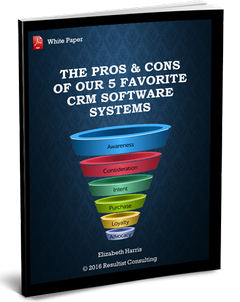
Sales forecasting is not simply a necessary evil mandated by finance. The best sales leaders use revenue forecasting as a tool to manage the business, support strategic decisions, and allocate resources. Estimating sales accurately for the upcoming 12 months gives your organization foresight into where your income is really coming from and when. Sales forecasts drive decisions related to:
- Production and inventory levels
- The number of staff needed
- Pricing structure
Strategy First
First and foremost, accurate forecasting requires a great sales strategy that considers what is necessary to move each pending deal to a close. A good strategy may include a SWOT analysis, or a clear understanding of customer’s criteria for decisions and how your company ranks against the criteria. More importantly, it will direct your tactics and help you determine the logical series of next steps.
Qualitative or Quantitative
There are many types and methods of sales forecasting. Forecast methods can be either qualitative or quantitative by design.
Quantitative forecasting methods use historical and current quantifiable data to predict future sales. Large amounts of available data is translated into future trends. Although a level of subjectivity is involved where people decide which methods to use and which forecasts are best, a primary objective of quantitative forecasts is to be as objective about the future as possible. There is a hope of removing the human element from the equation.
Common methods of quantitative forecasting include:
Time Series Model
> Moving Averages
> Exponential Smoothing
Casual Model
> Leading Indicators
> Econometric Modeling
Qualitative forecasting methods (also called subjective) are more focused on short term projections and generally broad in scope. These methods turn opinions and knowledge of industry experts into formal reports instead of using complex mathematical models. When there is no accurate or trustworthy historical data, qualitative methods are used. When quantitative methods seem inaccurate as they assume there will not be a radical departure from the patterns of the past, it may be time to tap into expert knowledge.
Common methods of qualitative forecasting you might see:
> Jury of Executive Opinion
> Delphi Method
> Sales Force Composite
Qualitative forecasting relies on expert opinions and have limits to the quantity of complex information used. If there are large data sets available, quantitative techniques are used for analysis but may fail when the market experiences unexpected changes. The best forecasts include an initial quantitative analysis with qualitative opinions from experts to make changes based off information initially considered.
Regardless of the forecasting method you select, it must align with your sales process.
“Every business has a sales process – the steps taken to make a sale. Documenting your sales process is a foundational piece of building a Predictable Revenue Machine.” - Elizabeth Harris
“If you do not know how to ask the right questions,
you discover nothing.” - W. Edwards Deming
With W. Edwards Denning’s quote in mind, ask the following questions to align your sales process and improve the accuracy of your sales forecasting:
Key considerations for sales processes:
- What type of sales process is most effective for your organization? Commodity or Consultative?
- Do you have a short selling cycle or a long selling cycle?
- Do you offer pre-set solutions? Or do you offer custom solutions?
- Do you sell to the mainstream or a specialized segment in the marketplace?
Understand the sales funnel elements:
- What are the definitions of each sales stage?
- What are the timing parameters?
- What are the internal and external sales activities?
- Do you know the steps required to advance the sale?
An accurate sales forecast depends on three things:
- Commitment by everyone in sales to keep complete and up-to-date records in the CRM.
- An agreement on clear definitions for each funnel stage and commitment to use the sales funnel by all.
- Realistic and honest forecasting about your team's opportunities.
Does your sales forecast include the following?
- Company
- Opportunity
- Proposal / Quote #
- Total $ Value
- Current Funnel %
- Anticipated Close Month
- % Probability of Close in Booking Month
- Forecast of $ Value

In terms of sales forecasting, each stage has a probability associated with it. An opportunity in the "Discovery" stage might have a probability of closing of 10%, while an opportunity in a later stage like “Verbal Committment” is very likely to closing, around 95%.
The methods of forecasting discussed above have advantages and disadvantages. No one method may be suitable. A combination of methods may give you the desired result. One which is quick, with minimal costs and more accuracy is ideal. The forecaster must be cautious while making decisions based on the sales forecast. Periodic review and revision of the forecast should be done, in light of actual performance.
The right sales forecasting method – and accompanying accurate sales forecasts – is critical to helping you manage your sales team and running your business. The right software tool makes the process much easier.
Using software
Today’s software programs have been designed to help create sales forecasts quickly and easily. For example, using customer relationship management (CRM) software will help track all opportunities, ensure that the right activities happen at the right time, and create an accurate forecast.
An accurate sales forecast relies on three fundamental elements:
- Selecting the best forecasting method for your company.
- Aligning your forecast to your sales process.
- Capturing and organizing your sales opportunities with the right CRM tool.
If you are planning to upgrade or replace your CRM software system to improve sales and generate a more accurate forecast, get our free whitepaper here:
"The Pros and Cons of Our 5 Favorite CRM Software Systems".

